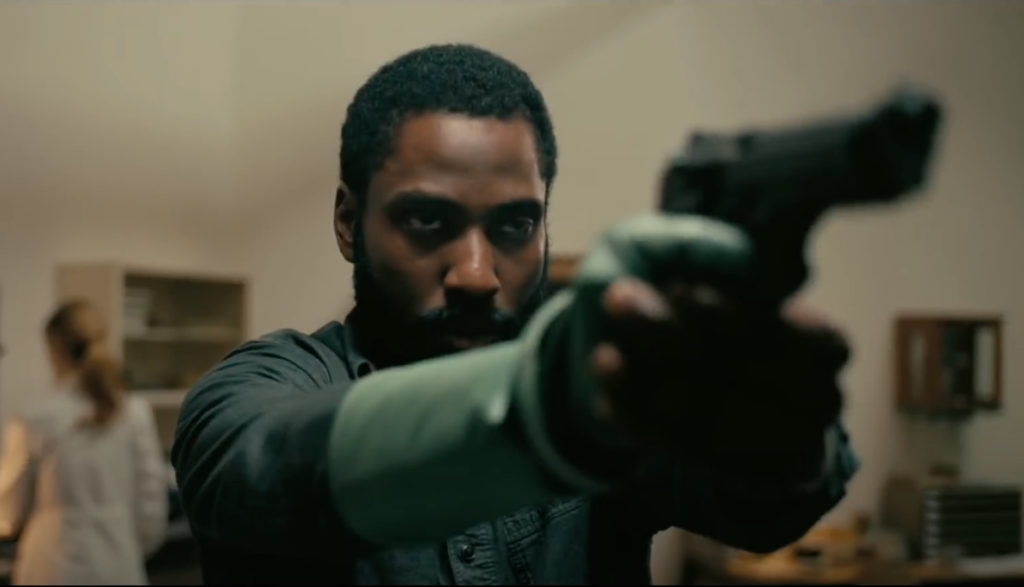
Time, it seems, is always our enemy.
It crawls in algebra class but flies when we’re with friends. Time tortures us when we have too much of it. It mocks us when we beg for more. We spend it and waste it and even kill it. And in the end, there’s never enough of it.
But as ruthless and relentless as time can be, we can comfort ourselves in the knowledge that whether it feels slow or fast, time marches just one way: forward.
Or does it?
Tenet’s hero, known simply as the Protagonist, thought he knew all he needed to know about time. After all, this CIA operative has spent much of his life racing against it. Why, when he’s taking part in a rescue mission in a Ukrainian opera house, the ticking time bombs he spots underneath a handful of seats must feel like old hat. And even when he’s captured by sadistic evildoers and tortured between two busy railroad tracks, the Protagonist can comfort himself knowing that the pain—however bad it might be—won’t last forever. Indeed, when he bites into a cyanide pill, he assumes that his time has reached its end.
But … no. He wakes up instead aboard a ship—his heart still ticking like a metronome. A man tells him that the pill was fake, his team is dead and the whole operation was, apparently, some sort of a test: a test of the Protagonist’s loyalty, his bravery, his ability.
He passed the test, but the reward? Hardly a gold watch. No, rather, he’s been selected to become a member of a group with an affinity for the word Tenet—a group tasked with saving the world from utter destruction. The threat, the Protagonist learns, isn’t nuclear, or biological, or chemical: It’s time itself.
Somehow, in the future, a select few have learned how to “invert” time. Bullets shoot backwards. Objects leap upward. Time itself becomes malleable. Say we typically think of time as a ball, rolling down a sloping sidewalk. With this new technology, that sidewalk can be pulled up, like a ribbon, and tilted the other way, sending the ball of time rolling backward.
That, on the surface, might seem like a grand thing: Those who created it hoped the technology would be used to set some wrongs to right.
But every technological advance comes with a Pandora’s box of problems. And when the advance dares dabble with time itself, the box is pretty big. Shifting time can destroy the world.
The Russian oligarch Andrei Sator seems to want to do just that.
Our Protagonist has raced against time time and again. But how can he win when time itself cheats?
We know that the Protagonist (he’s never given a name during the film) is no coward. His “test” proved as much. “You chose to die instead of giving up your colleagues,” he’s told, and it’s true.
But he also shows, ultimately, a certain tenderness toward Kat, Sator’s wife. While this could obviously head toward some problematic places, the film never really goes there. The Protagonist’s feelings for the woman, whatever they might be, manifest themselves in, simply, how much he’s willing to risk and sacrifice for her—and that winds up being quite a bit. One could argue with the Protagonist’s decisions, but his desire to save and protect this woman should not be overlooked. And he’s also motivated, in part, by the fact that Sator has, in some ways, been a monstrously cruel husband as well.
Kat, meanwhile, is determined to protect and save her son. She tells the Protagonist that her little boy “everything” to her, and she’s sacrificed a great deal to keep him safe and keep him as close as she can.
Obviously, plenty of people risk their lives to save the world. That’s especially true of the Protagonist and another agent he works with named Neil. Neil, in particular, shows a special time-shifting dexterity, skimming across its currents like a chronological surfer. He saves the Protagonist’s life more than once.
Sator speculates whether God will forgive him for bringing a child into a world that seems to be ending. He also suggests that his power over time makes him “a god of sorts” himself. There’s a reference to Armageddon. Because Tenet revolves around the malleability of time, characters sometimes talk about free will and fate. And at least one person suggests that he has “faith” that ultimately time will work itself out.
Sir Michael Crosby, a deep-pocketed English gentleman who helps bankroll the Protagonist’s adventures, suggests that the Protagonist reach Sator through his wife, Kat. The Protagonist suggests that Crosby’s overestimating “my powers of seduction.” Indeed, the Protagonist never seduces Kat (nor she him), but the suggestion that the two are having an affair becomes a tool for the Protagonists to get closer to Sator. In fact, when the two first meet, Sator’s first words are, “Have you slept with my wife yet?” “No,” the Protagonist tells him coyly. “Not yet.” Speaking of seduction, Kat hopes to do just that with her own husband (the two are on the verge of being estranged) in order to buy the Protagonist and his team time. In this context, Sator talks of “making love” to his wife, and seems quite ready to do just that. Kat wears a bikini at one point (often partially a bit by a shawl-like, see-through covering she also wears). Other outfits reveal some leg and cleavage. Both the Protagonist and Sator are shirtless once or twice.
The violence in Tenet can feel a bit different from other action films because of its time-bending setup. But the takeaway is this: Bullets always hurt when they hit you, whether they’re being fired from a gun or sucked back into the barrel. One person suffers a bloody, apparently lethal wound from just such a time-shifting shot. We see a corresponding, and blood-tinged, bullet dent in the glass in front of the victim, too. Many people are shot, sometimes in cold blood, and die. Explosions take out others. Someone is shot and pushed off a ledge, bouncing grotesquely down. Another guy falls down a very deep hole. Someone is nearly killed by drowning. Cars crash (and uncrash). Buildings explode, reform and explode again. (They explode in more conventional ways, too.) It’s suggested that someone kills someone else with a shovel. As the story ramps up, a military unfolds between two large groups of heavily armed combatants. It includes firefights, rocket launchers and buildings being destroyed, with many casualties on both sides. Most of the violence we see generally falls comfortably into PG-13 territory. But what we don’t see can feel, ironically, more jarring. An example: Sator beats a man to death with a gold bar. While the actual attack is shielded from the camera (partly by Sator’s own body), we know exactly what’s happening and, as if to add emphasis, Sator flips the bloodied gold brick to someone after he’s done with his murder. Another: We don’t see the Protagonist tortured in the movie’s opening moments, but we see blood and instruments of torture, as well as one or two lifeless corpses (people we assume expired as a result of said torture). Later, the Protagonist tells someone that his tormenter was pulling teeth out, one by one. Still another: When Kat does something that Sator disapproves of, Sator stalks into her bedroom, removes his belt and fastens cufflinks to the strap, creating a makeshift scourge. (He stops short of using it.) And when Sator believes that the Protagonist has designs on his wife, the Russian makes some extremely descriptive threats—ones involving critical body parts being stuffed into the Protagonist’s throat, asphyxiating him. A woman is hit and kicked by her husband. People fight with each other. Someone gets stabbed (and suffers blood loss before getting the actual wound). Some characters are injected with needles. People tumble out of moving planes. Someone finds himself trapped in a car as it explodes—but because of the weird nature of inverted time, the man is at risk of freezing to death, rather than burning. Special vaults are equipped with gas (designed to smother fires) that will also smother people trapped there. The Protagonist bites into a cyanide pill he believes will kill him. A character is suffering from terminal cancer. We hear a great deal of talk about the end of the world.
One f-word and at least four s-words. We also hear “a–,” “b—ch,” “p-ss,” “g-dd–n,” “h—” and the British profanity “bloody.” Jesus’ name is abused twice.
Characters drink wine and other mixed drinks with meals and vodka elsewhere.
When you can’t trust time, who or what can you trust? No one, apparently. People lie to and betray other people—often for worthwhile reasons, but the betrayals still add up. A cargo plane is swiped and used to break into a heavily guarded “freeport.” The gold bars the plane carries are thrown out (and indirectly distributed to others with no claim on said gold bars) as a distraction.
Director Christopher Nolan has something in common with the villainous Andrei Sator: Both treat time as their own personal plaything. Memento, the R-rated movie that put Nolan on the map, is a story told backward. His sci-fi epic Interstellar featured a time-bending black hole and a tantrum-prone chronology. Even Dunkirk, a relatively straightforward war movie, featured three separate timelines stitched together into one improbably cohesive narrative. At the time, Nolan described Dunkirk as “the most ambitious film we’ve made.” Or, at least, it was. ’Til now. Tenet may not be Nolan’s greatest film, but it’s by far his most confusing, and that’s saying something. While Neil (the Protagonist’s right-hand man) brags that he has a master’s degree in physics and, thus, might be able to follow the plot of his own movie, the Protagonist—and moviegoers—just have to muddle through as best as we can. Nolan takes on every paradox endemic to time-travel stories and pushes them all to the wall, creating either an extraordinarily smart or rather pretentious flick. (I’m inclined to give Nolan the benefit of the doubt, but maybe it’s a bit of both.) I have a feeling that a good chunk of Tenet’s box office might be made from folks seeing the film a second time or even third time—just to figure out what was going on the first time they saw it. They certainly won’t go for the film’s emotional resonance. Nolan’s works tend to feel a bit chilly if they don’t have a compelling emotional anchor, and Tenet suffers from the lack of one. And given some of its allusions to torture and abuse and beatings with gold bars, Tenet can feel pretty grim, as well. The film’s actual violence is generally less severe than you’d see in a typical superhero or Mission Impossible movie—and yet, it feels harsher. Add to that its smattering of profanities, and Tenet warrants some serious caution—especially for younger viewers. But for those who love a little serious sci-fi in their blockbusters, and who dig movies that don’t just talk down to them but force them to think and stuff, Tenet will likely inspire as many smiles as head-scratches. While it’s not perfect, this Christopher Nolan sci-fi puzzler deserves, at least, some tenet-ive consideration.


Paul Asay has been part of the Plugged In staff since 2007, watching and reviewing roughly 15 quintillion movies and television shows. He’s written for a number of other publications, too, including Time, The Washington Post and Christianity Today. The author of several books, Paul loves to find spirituality in unexpected places, including popular entertainment, and he loves all things superhero. His vices include James Bond films, Mountain Dew and terrible B-grade movies. He’s married, has two children and a neurotic dog, runs marathons on occasion and hopes to someday own his own tuxedo. Feel free to follow him on Twitter @AsayPaul.